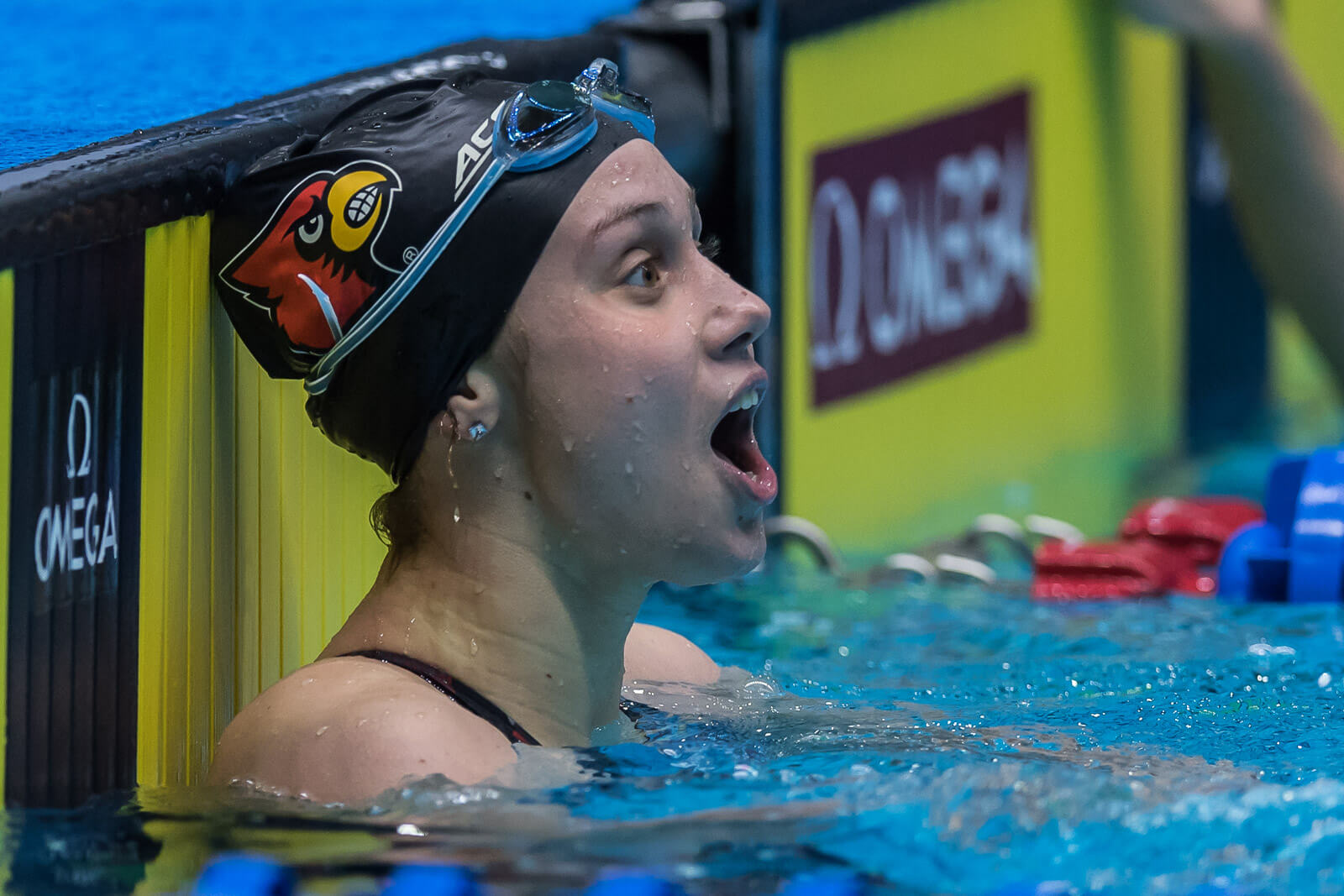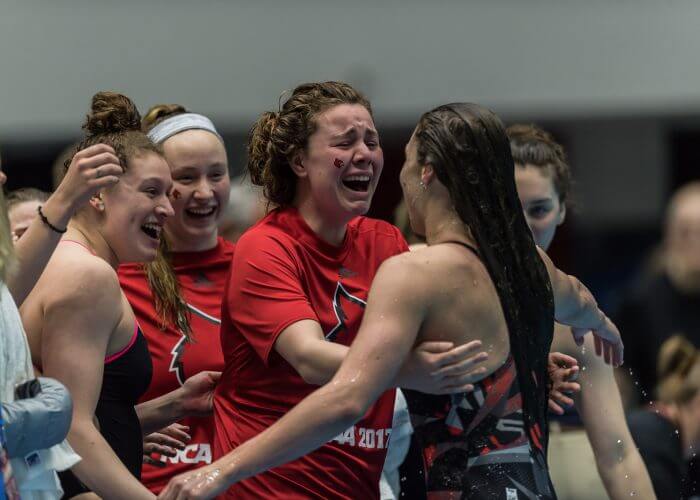Mallory Comerford’s Rise and Her Breakthrough Moment

NCAA DI editorial coverage is proudly sponsored by Adidas. Visit adidasswimming.com for more information on our sponsor. For all the latest coverage, check out our event coverage page.
 CLICK FOR FULL RESULTS
CLICK FOR FULL RESULTS
By David Rieder.
It was billed as a showdown between Olympic gold medalists and Stanford teammates Katie Ledecky and Simone Manuel, but after 150 yards, there was just one problem: Mallory Comerford would not go away.
The Louisville sophomore had arrived at the women’s NCAA championships in Indianapolis with the third-fastest seed time in the 200 freestyle at 1:41.70. That swim at the ACC championships had been impressive, even eye-opening, but Manuel and Ledecky each posted times more than a second faster the next week at the Pac-12 meet.
One day earlier, Ledecky had won the 500 free in American record-time, and Manuel had finished with the second-fastest time ever in the 50 free to win the title. Comerford, meanwhile, ended up fourth in the 500 in 4:36.16, more than 12 seconds back of Ledecky.
But perhaps not-so-quietly, Comerford had put up the quickest split in the field during each of the meet’s first three relays. When the time arrived for the 200 free, Louisville head coach Arthur Albiero believed she was capable of something special.
But a 1:40.36 and a tie with Ledecky for a national championship? Nope, even that did not surprise Albiero.
“Yes. We believed. We never set out a limit,” Albiero said. “There was nothing surprising about her race, to be honest with you. That was the plan—keep it close, make your move, and let’s see what you got.”
Comerford flipped at the 150 more than a half-second behind Manuel and a tenth behind Ledecky, but she had something left. Comerford finished in 25.53, faster than even the legendary distance ace swimming one lane over.
The duo touched the wall, and “1” flashed up on the scoreboard next to both names. Despite the obvious improbabilities of two swimmers touching at the exact same hundredth, it was the time next to Comerford’s name that was most stunning—a time only Missy Franklin has ever bettered.
“When I saw the board, it was just kind of unreal,” Comerford said. “It’s still kind of unreal. I don’t really know what to think. It’s really cool, and it’s such an honor. All my teammates were crying, but I didn’t cry until someone filmed the reaction. That was really cool and something I’ll never forget, seeing them and how proud they were of me.”

Photo Courtesy: Peter H. Bick
Comerford became the second Louisville woman to win an individual NCAA championship, and the now-graduated butterflyer who was first was front and center as a witness.
Kelsi Worrell had been on deck to present the awards to the top eight in her signature event, the 100 fly, and she stood with her former teammates during the 200 free final.
“I’m watching the coaches get her splits and hearing, ‘She’s going faster than she ever has before,’ and it’s setting in,” Worrell said. “I can’t control myself, I’m shaking and crying and trying not to pee myself. Just so incredible.”
All day, Worrell had insisted that Comerford would get her hand on the wall first. Who would know better, especially since Worrell had watched the Comerford’s rapid rise to notoriety first-hand, beginning less than two years ago when Comerford arrived at Louisville.
“Arthur was just reminiscing on her first practice. During underwaters, she didn’t think she was going to make it,” Worrell said. “She has just improved exponentially.”
She did not arrive a superstar, but Comerford would not be intimidated. She proved that quickly her freshman year, first at the ACC championships, when she touched out soon-to-be Olympian Leah Smith in the 200 free, and then at her first NCAA championships, when she came from behind to finish second.
Her next step, naturally, would be the Olympic Trials in Omaha, but long course would be a different animal. Comerford arrived at Louisville with hardly any experience in the Olympic-sized pool and was not making that up overnight.
Despite that, Albiero thinks that Comerford believed she was going to make the Olympic team, but she was eliminated in the semifinals of both the 200 free and 100 free.
“She was heartbroken that she was not in the final,” Albiero said. “As a coach, you just want to give them an environment to dream big, and then it’s open ended—let’s go see what we can do. Some of those things started there.”
But even after the Trials setback, Comerford’s chance to represent the U.S. would come soon enough, when she was selected to compete at the Short Course World Championships. She finished fifth in the 200 free in Windsor and anchored two U.S. relays to gold medals.
“Worlds was an incredible experience for her to be thrown in that situation where it was not about here. It was about Team USA. And she had to digest that right away,” Albiero said. “I think just being in that environment and feeling like you belong, it’s something really unique and special.”
“In the past year I’ve learned so much. Racing at Worlds, racing against the best in the world, and even a week and a half ago racing here in Indy (at the arena Pro Swim Series) against some of the best swimmers in the world, those experiences have really, really helped me learn how to control my emotions, control my emotions and learn from them and how they race,” Comerford said.
By the time she got back to Indianapolis for her second NCAA championship, Comerford had professed plenty of respect for the big names, but the heat sheets and caps would not phase her. And now she has an NCAA championship to show for it.
“That’s really what we’ve been working for, 1:40,” Comerford said. “In practice, we’ve been pushing 25.5s, holding that consistent, just swimming the race just like that. Coming into this year I didn’t want to limit myself, just go out and have fun.”
During the awards presentation for the 200 free, Ledecky and Comerford shared the top step on the podium, with the step below vacant and Manuel one more slot below that. Ledecky accepted her award first and waved to the crowd, another box checked off in her historic run through her inaugural NCAA championship.
A few moments later, Comerford took her trophy and lifted it high in the air. Elbows locked, she froze and beamed.
She trained for it and believed in her ability, but that didn’t mean she relished the moment any less.
All commentaries are the opinion of the author and do not necessarily reflect the views of Swimming World Magazine nor its staff.




.jpg)

enjoy it while you can…we will see how you do in Nationals/Worlds this Summer… Mallory who???
Class act maloney.
I came from the lillia KING CHARM school….
This is a very nasty comment. Did someone not get enough sleep? It was an incredible swim by Mallory. Congratulations to this amazing swimmer.
Incredible…look the word up..shes a self proclaimed sprinter right…a tie..is not incredible….0 wr…not incredible…0 ncaa/american records..not incredible….WE will witness INCREDIBLE tonight in the 1650..just saying
Michael Maloney is obviously not operating on all cylinders. Ms. Comerford’s 2 free ties for the second fastest SCY 2 free in history. That in and of itself is incredible. We’re talking about Mal in the same breath as two Olympic gold medalists, one of whom all would say is drop dead dominant.
Such an inspirational story. Very well written David. I am excited for Ms. Comerford and the future of Louisville’s program.
Congrats to Mallory’s club coach Jeff Russell at SWYM, although they get no credit, club coaches spend years building the foundation for the athletes future success. Mallory was a top club swimmer in Michigan before heading to Louisville. Those of us that watched her over the years are not surprise by her current success.